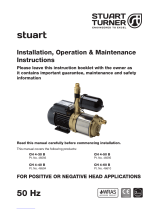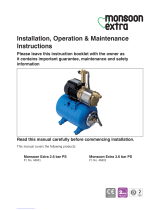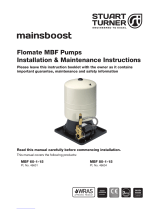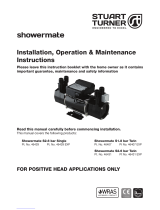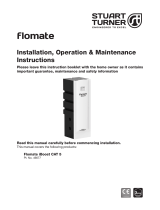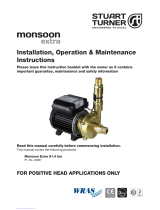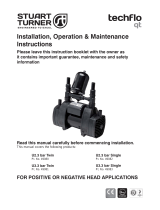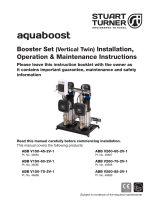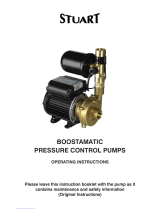Page is loading ...

Installation, Operation & Maintenance
Instructions
Please leave this instruction booklet with the owner as it contains
important guarantee, maintenance and safety information
Read this manual carefully before commencing installation.
This manual covers the following products:
CE compliant product
Jet 55-45 B
Pt. No. 46619
Jet 80-45 B
Pt. No. 46620

- 2 -
Cont ...
PRODUCT DESCRIPTION
Electric motor driven centrifugal pump complete with an automatic control system,
consisting of flow switch, pressure switch, pressure vessel and electronic control.
APPLICATION
The Stuart Jet Boostamatic range is designed for pressure boosting applications in vented
stored, cold, clean water systems, where under gravity, no flow is available and can be
used in systems where either a positive or negative head exists.
Inlet pressures to the pump and ambient temperatures must not exceed the
values given in the technical specifications.
This pump set must not be used for any other
application without the written consent of Stuart
Turner Limited.
This pump MUST NOT be connected directly to
the mains water supply.
This appliance can be used by children aged from
8 years and above and persons with reduced
physical, sensory or mental capabilities or lack
of experience and knowledge if they have been
given supervision or instruction concerning use of
the appliance in a safe way and understand the
hazards involved. Children shall not play with the
appliance. Cleaning and user maintenance shall
not be made by children without supervision.
Children should be supervised to ensure that they
do not play with the appliance.
This product should not be used for the supply of
water to more than one dwelling (house,
apartment, flat).
Please read installation details carefully as they are intended to ensure this
product provides long, trouble free service. Failure to install the unit in
accordance with the installation instructions will lead to invalidation of the
warranty.
STORAGE
If this product is not to be installed immediately on receipt, ensure that it is stored in a dry,
frost and vibration free location in its original packaging.

- 3 -
Cont ...
CONTENTS Page
Checklist . . . . . . . . . . . . . . . . . . . . . . . . . . . . . . . . . . . . . . . . . . . . . . . . . . . . . . . . 4
Pre-Installation . . . . . . . . . . . . . . . . . . . . . . . . . . . . . . . . . . . . . . . . . . . . . . . . . . . 5
Important Facts - read before commencing installation . . . . . . . . . . . . . . . . . . . 6
Location . . . . . . . . . . . . . . . . . . . . . . . . . . . . . . . . . . . . . . . . . . . . . . . . . . . . . . . . 7
Electrical Installation . . . . . . . . . . . . . . . . . . . . . . . . . . . . . . . . . . . . . . . . . . . . . . . 10
Commissioning . . . . . . . . . . . . . . . . . . . . . . . . . . . . . . . . . . . . . . . . . . . . . . . . . . . 12
Maintenance . . . . . . . . . . . . . . . . . . . . . . . . . . . . . . . . . . . . . . . . . . . . . . . . . . . . . 14
Technical Specifi cation . . . . . . . . . . . . . . . . . . . . . . . . . . . . . . . . . . . . . . . . . . . . . 15
Trouble Shooting . . . . . . . . . . . . . . . . . . . . . . . . . . . . . . . . . . . . . . . . . . . . . . . . . 16
Guarantee . . . . . . . . . . . . . . . . . . . . . . . . . . . . . . . . . . . . . . . . . . . . . . . . . . . . . . . 19

- 4 -
Cont ...
CHECKLIST
Your product may vary slightly from the picture above.
Item Description Qty Item Description Qty
Pump 1 Pressure vessel 1
Fig. 1
A
A
B
B
IMPORTANT: With the pump
removed from its packaging
check for any damage prior to
installation. If any damage is found
contact Stuart Turner Ltd within 24
hours of receipt.

- 5 -
PRE-INSTALLATION ASSEMBLY
Re-positioning of Pressure Vessel
The pressure vessel can be rotated to alternative positions (Fig. 3) in the event of the
factory fitted position being unsuitable for a specific installation.
1 Remove pressure vessel by unscrewing anti-clockwise.
2 Using a 2 mm allen key, carefully loosen all three retaining grub screws by two
turns (Fig. 2).
3 Warning - Care must be taken when re-positioning the pressure vessel to
ensure no strain is placed upon the pressure
switch or reed switch cables.
The flow switch assembly can now be carefully
rotated to an alternative position
(Fig. 3).
4 Ensure all three grub screws are
re-tightened securely to a torque
of 2.2 Nm (1.62 ft lbf).
5 Re-fit the pressure vessel
ensuring the ‘O’-ring seal
is in place.
Fig. 2
Grub Screws
(3 off)
Outlet Tower can be swivelled at
this joint line after loosening the
3 equi-spaced grub screws
Motor
Area for alternative fitting positions
Factory fitted position all models
Fig. 3

- 6 -
Cont ...
1 READ BEFORE COMMENCING PUMP INSTALLATION
A. Water storage capacity.
1.11 The cold water storage capacity must be sufficient to meet the flow rates
required by the pumped equipment and any other water using fittings and
appliances, which may be operated simultaneously.
1.12 Ensure the pump is primed as described in the priming section before starting,
damage to the shaft seal will result otherwise. See Section 4 - Commissioning.
B. Water temperature
The water entering the pump must be controlled as follows:
1.13 The maximum allowable water temperature is 35 oC.
1.14 The minimum allowable water temperature is 4 oC.
C. Pipework - General
1.15 Secure pipework: Ensure pipework to and from pump is independently
supported & clipped to prevent forces being transferred to inlet and outlet
branches of pump.
1.16 Flux: Solder joints must be completed and flux residues removed prior to pump
installation (flux damage will void any warranty).
1.17 Pipework design: Care should be taken in the design of pipework runs to
minimize the risk of air locks e.g. use drawn bends rather than 90o bends.
1.18 DO NOT introduce solder flux to pumps or pump parts manufactured
from plastic.
1.19 DO NOT allow contact with oil or cellulose based paints, paint thinners or
strippers, acid based descalents or aggressive cleaning agents.
1.20 DO NOT install a non-return valve, or devices which contain non-return
valves, in the suction (inlet) pipework to the pump. The pump must be
free to vent to the supply tank at all times unless pump in suction lift
application.
1.21 DO NOT connect this pump to the mains water supply.
D. Plumbing Installation Regulations
1.22 The plumbing installation must comply with “The Water Supply (Water Fittings)
Regulations 1999” and “BS 6700” building regulations.
1.23 The plumbing installation must be installed by a qualified person.
1.24 The electrical installation must be carried out in accordance with the current
national electrical regulations.
1.25 The electrical installation must be installed by a qualified person.
E. Pressure vessel
1.26 Pressure vessel is charged at the factory see Section 5 - Maintenance for
details.

- 7 -
Cont ...
2 LOCATION - GENERAL
2.11 Access: For emergencies and maintenance the pump must be
easily accessible.
2.12 Protection: The pump must be located in a dry position, frost free
and protected from freezing, particularly when installed in a loft (not
recommended).
2.13 Ventilation: Ensure an adequate air flow to cool the pump. Separate
the pump from other appliances that generate heat. An 80 mm (3 “)
air gap must be maintained around the pump.
2.14 Safety: The motor casing can become very hot under normal
operating conditions. Care must be taken to ensure it cannot be
touched during operation.
2.15 Water retention: Site the pump in a location where in the unlikely
event of a water leak, any spillage is contained or routed to avoid
electrics or areas sensitive to water damage.
2.16 Static inlet pressure: Before deciding where to locate the unit check to ensure
the static inlet head between pump and cold water level (Fig. 4) is at least
1 metre and does not exceed the max inlet head of 5 metres.
2.17 Pump position: The pump must be positioned as close to the water source as
possible. The pump has a side mounted terminal box. Ensure the pump is
mounted in a position that allows easy access to the box if required.
2.18 Ambient temperature: The pump must be sited in a location where the
maximum ambient temperature does not exceed 40 oC.
2.19 Pipework: For optimum performance pipework 28 mm should be used. 22 mm
is acceptable, however, any pipe size reduction will reduce the pumps
performance.
2.20 Static outlet pressure: The static outlet head (Fig. 4) must also be within the
maximum requirement of 13 metres.
2.21 Direction of flow: Ensure the water flow is in the direction of the arrow marked
on the flow switch reed clamp (vertically upwards).
2.22 Isolating valves: If permanently installed, isolating valves should be fitted in
suction and delivery pipework to enable easy isolation and access to the pump.
2.23 Inline strainer: When pump is to be installed in areas where there is risk of
debris or scale build up within the system, you MUST ensure the inlet pipework
is fitted with an inline strainer.
2.24 Suction lift: This pump is capable of a maximum suction lift of 5 m in this case
only, an NRV in the footvalve is permissible (Fig. 5).

- 9 -
Cont ...
2.26 Self Priming: Jet 55-45 B and 80-45 B pumps are capable of self priming the
suction hose assembly, providing a footvalve and strainer (not supplied) is
always used for this type of installation. The Jet pump can be used in a suction
lift installation providing the height of lift is no greater than maximum permitted
(Fig. 5). For full priming procedure see section 4.13.
2.27 Footvalve/strainer: It is important that the optional footvalve and strainer is
always used for suction lift installations.
2.28 Suction pipe: Lay the suction piping over the shortest possible distance and
ensure there is a constant rise from the water source to the pump. Any high
spots will cause air pockets to form reducing system efficiency. The suction hose
must be a minimum of 25 mm to ensure the pump is not starved of water and
must be reinforced to prevent it collapsing.
2.29 Connections: Ensure all joints in suction pipework are completely airtight.
Failure to comply will result in loss of prime.
2.30 Position: The intake of the footvalve/strainer should be positioned so that it
cannot be blocked with debris or silt that are frequently found in the bottom of
sumps and wells.
2 LOCATION - PUMP MOUNTED ABOVE WATER SOURCE (SUCTION
LIFT INSTALLATION)
Fig. 5
Ensure inlet area
around strainer is
free from debris
Max. suction lift 5 m
0.5 m min

- 10 -
3 ELECTRICAL INSTALLATION / EARTHING
3.11 Regulations: The electrical installation must be carried out in
accordance with the current national electrical regulations and installed
by a qualified person.
3.12 Safety: In the interests of electrical safety a 30 mA residual current
device (R.C.D. not supplied) should be installed in the supply circuit.
This may be part of a consumer unit or a separate unit.
3.13 Before starting work on the electrical supply ensure power supply is
isolated.
3.14 DO NOT allow the supply cord to contact hot surfaces, including the
motor shell, pump body or pipework. The cord should be safely routed
and secured by cable clips.
3.15 Adjacent pipes: Adjacent suction and delivery pipes should be fitted with
earthing clamps in accordance with current regulations (Fig. 6).
3.16 Earthing: This appliance must be earthed via the supply cord, which must be
correctly connected to the earth point located in the terminal box.
3.17 Pipework: Copper or metallic pipework must have supplementary earth
bonding where the continuity has been broken by flexible hoses or plastic
components (not supplied).
3.18 Additional earthing: Certain installations may require additional earthing
arrangements such as equipotential bonding. Reference should be made to the
relevant regulations concerning this subject to ensure compliance.
3.19 Connections: The pump must be permanently connected to the fixed wiring of
the mains supply using the factory fitted supply cord, this must be a fused spur
off the ring main and NOT connected to the boiler or the immersion heater
circuits.
3.20 Wiring of connection unit:
WARNING: This appliance must be earthed.
The wires in the mains lead are coloured in accordance with the
following code:
Green and Yellow: Earth Blue: Neutral Brown: Live
As the colours of the wires in the mains lead of this appliance may not
correspond with the coloured markings identifying the terminals in your
connection unit proceed as follows:
Diagram of
earth continuity
connections
Fig. 6

- 11 -
Cont ...
The wire which is coloured green and yellow must be connected to the terminal
in the connection unit which is marked with the letter E or by the earth
symbol:
or coloured green or green and yellow.
The wire which is coloured blue must be connected to the terminal which is
marked with the letter N or coloured black.
The wire which is coloured brown must be connected to the terminal which is
marked with the letter L or coloured red.
3.21 Wiring Diagram:
The supply cord and internal wiring within the terminal box are
routed and secured to ensure compliance with the electrical
standard EN 60335-1. It is essential that any disturbance of
this internal wiring is avoided and the factory routing and
securing of all internal wiring is always maintained.
Model Fuse Size (AMPS)
All Models 13
3.22 Fuses: The following fuse size should be used with the appropriate pump:
GREEN / YELLOW
BLUE
BROWN L
MA
N
NLE
N230 VAC/1PH/50Hz
SUPPLY
RED
CAPACITOR
MOTOR
GREEN / YELLOW (LINK WIRE)
RED
YELLOW
RED
BLACK
BLACK
FLOWSWITCH
REED (S3)
S3 S3 S2S2S1 S1
PRESSURE
SWITCH (S1)
All models
Fig. 7

- 12 -
Cont ...
4.14 Suction lift installation: Self priming of suction hose.
First ensure both suction and delivery hose connections are airtight. Remove the
priming plug (Fig. 8) and slowly fill the pump body with water, whilst allowing the
air to escape. Replace the plug.
4.15 Suction hose: Ensure the suction hose end is fully submerged in the water
source and the delivery hose is open to enable the pump to vent air.
4.16 Starting the pump:
a) Ensure all outlets are closed, turn power supply ‘on’ - pump will start,
pressurise the system then stop.
b) Open and close all outlets in turn associated with the pump, allowing water
to flow from each outlet until all air is purged. As each outlet is opened and
closed, the pump will start and stop respectively.
Note: After closing the outlet there will be a small time delay before the
pump stops, which is normal.
4 COMMISSIONING
4.11 System Flushing: The pipework system should be flushed out
prior to the pump being connected to ensure any contaminants/
chemical residues and foreign bodies are removed from elsewhere
in the system.
4.12 Water Supply: Always ensure that water storage capacity is adequate to meet
the demand. Ensure the pump chamber is full of water before starting the
pump. Failure to do this could result in seal damage. To ensure dry running
does not occur the pump must be primed as described in priming section below.
Do not run pump dry.
4.13 Priming: Prior to switching the pump on and connecting the outlet hoses to
the system pipework the pump chamber must be primed. The pump must be
primed (filled with water) before starting. Turn on water supply, prime and vent
the pump by unscrewing the priming plug (Fig. 8) slowly until all air escapes and
water emerges. Re-tighten the plug.
Fig. 8
Priming/vent
Plug
Drain
Plug

- 13 -
Cont ...
c) Any tap or control valve within the system when opened and closed will now
turn the pump on/off. Providing this is the case the system is now operating
correctly.
d) Carefully check pump and pipework for leaks whilst pump running and
stationary before leaving the installation unattended.
Do not run pump without guards and terminal box lid
correctly fitted.
The pump chamber must be full of water at all times. Seal
damage will result if the pump runs dry.
4.17 For Further Technical Support: Phone the Stuart Turner PumpAssist team
on +44 (0) 844 98 000 97. Our staff are trained to help and advise you over the
phone.

- 14 -
Cont ...
5 MAINTENANCE
5.11 Pressure vessel: The pressure vessel should be checked once every 6 months
to have its air charge checked or replenished, this should be carried out
as follows:-
a) Isolate pump electrically.
b) Isolate the water supply by closing the appropriate isolating valves.
c) Release system water pressure by opening a system outlet on the system.
d) Remove pressure vessel from the pump taking care to collect or absorb any
residual water using towels.
e) Check air charge at Schrader valve (Fig. 9) using a tyre pressure gauge.
f) Replenish air charge if required by injecting air into the vessel via the
Schrader valve using a car or bicycle pump, see Pre-installation assembly.
g) Reassemble pressure vessel to pump hand tight to achieve a water tight
connection. Ensure sealing ‘O’-ring is in place.
h) Close all system outlets, open inlet and outlet isolating valves.
i) After maintenance is completed refer to Section 4 - Commissioning for
instructions on re-starting pump.
5.12 Cleaners, Disinfectants and Descalents:
Acid based descalents and aggressive cleaning agents must not
come into contact with the pump. The pump must be removed from
the system prior to the use of these products. The system should be
flushed to remove all chemicals before the pump is re-connected.
If in any doubt as to the suitability of the chemical solutions, please
contact our PumpAssist helpline on +44 (0) 844 98 000 97.
Fig. 9
Detail view of
‘O’-Ring groove
in fitting point
‘O’-Ring
Schrader valve
(under cap)
Pressure vessel
‘O’-Ring
Fitting point
Model Air Precharge
bar (psi)
All other
models 2.0 (29)
NOTE: Do not over tighten pressure vessel.

- 15 -
6 TECHNICAL SPECIFICATION
Stuart Turner reserve the right to amend the specification in line with its policy of
continuous development of its products.
*Note: Max working pressure is the maximum pressure that can be applied to
the pump internal casing under any installation conditions.
6.11 Noise: The equivalent continuous A-weighted sound pressure level at a
distance of 1 metre from the pump does not exceed 73 dB(A) for Jet 55-45 B or
76 dB(A) for Jet 80-45 B.
Pump Model Jet 55-45 B
46619
Jet 80-45 B
46620
General Guarantee 1 year
Features Pump type Centrifugal
Mechanical seal EPDM / Carbon / Ceramic
Fully automatic control
Built in ‘no water’ cut out
Positive and negative head application
Quiet operation
Performance Maximum head (closed valve) 4.5 bar 4.2 bar
Performance @ 10 l/min 3.1 bar 3.2 bar
Performance @ 40 l/min 1.2 bar 2.2 bar
Maximum flow 53 l/min 75 l/min
Manimum static inlet pressure 0.1 bar (1 metre)
Maximum static inlet pressure 0.5 bar (5 metres)
Maximum static outlet pressure 1.3 bar (13 metres)
Maximum working pressure* 500 kPa (5 bar) 470 kPa (4.7 bar)
Maximum ambient air temperature 40 oC
Min / Max water temperature Min 4 oC / Max 35 oC
Maximum suction lift 5 metres
Cut out flow 1 l/min (approx)
Cut in pressure 180 kPa (1.8 bar)
Pressure vessel air pre-charge 2.0 bar (29 psi)
Connections Pump connections G 1 female
Motor Type Induction, auto-reset thermal trip
Duty rating Continuous (S1)
Electrical Power supply / phase / frequency 230 V a.c. / 1 / 50 Hz
Current (full load) 2.9 Amps 5.2 Amps
Power consumption 640 Watts 925 Watts
Fuse rating 13 Amps
Power cable (pre-wired) 1.5 metres
Physical Enclosure protection IPX4
Length 341 mm 368 mm
Width 207 mm 214 mm
Height (excluding hoses) 327 mm
Weight (including fittings) 9.8 Kg 12.2 Kg

- 16 -
Cont ...
7 TROUBLE SHOOTING GUIDE
Symptoms Probable Cause Recommended Action
Pump will not start. Electrical supply. Check wiring connections.
Check all switches are ‘on’.
Check fuse (see fuse section).
Check circuit breaker is set.
Faulty reed switch/PCB,
pressure switch
Contact PumpAssist.
Recommended static inlet/
outlet heads exceeded.
Re-position pump (see Section 2 - Location).
Internal motor thermotrip
activated.
Wait for thermotrip to cool and auto-reset and investigate
cause of problem before re-starting.
Water starvation to pump. Refer to ‘dry running’ section.
Pump starts when outlets are
off.
Leak in system. Check tap washers, w/c valve washers, pipe joints.
or
Pump cycles (hunts) on/off
frequently.
Low charge pressure in
pressure vessel.
Check charge pressure in pressure vessel
(see Section 5 - Maintenance).
Debris under non-return valve
sealing face.
Run at full flow to try and flush away debris or remove, clean
or replace non-return valve.
Pump runs on when all terminal
outlets are closed.
Leak in system. Check tap washers, w/c valve washers, pipe joints.
Reed clamp out of position. Ensure reed clamp is fitted correctly in location groove.
Faulty reed switch or P.C.B,
pressure switch
If pump continues to run, this indicates a closed circuit in
either the flow switch reed or P.C.B. in the terminal box, these
should be checked electrically.
Jammed flow switch. Isolate the pump electrically and hydraulically and remove
brass housing that contains the float. Check float for free
movement.
Pump runs, but no water. Pump air locked. Remove priming plug, fill with water.
Refit plug.
Water supply low. Check water level in the supply tank or well and all stopcocks
are open.
Check outlet not restricted or blocked.
Inlet filter/strainer blocked (if
fitted).
Remove and clean filter gauze/strainer.
Blocked suction pipe. Clean footvalve/strainer.
Air bubbles in suction pipe. Check connections are all airtight.
Pump runs but no water on
suction lift installation.
Lack of priming water. Prime pump casing.
Insufficient time allowed for
priming to be completed.
Amount of time taken to prime suction pipe will vary
dependent upon model selected and suction lift height.
After 5 minutes repeat priming procedure.
Reduced flow/performance. Blocked shower head spray
plate.
Clean in accordance with manufacturers instructions.
Blocked pipework or pump. Isolate pump electrically and hydraulically, locate blockage
and remove.

- 17 -
Cont ...
7.11 Dry Run Protection:
This pump is fitted with a safety control circuit, which will detect the following
fault condition:
Dry running caused by water starvation to the pump.
Should the pump run out of water it will stop as part of a “protective logic
sequence”, detailed below.
The fault should be rectified before re-starting the pump. Check that there is
sufficient water supply to the pump and also ensure that all terminal fitting
outlets are closed.
7.12 Protective Logic Sequence: If water starvation occurs and the power supply
to the pump remains uninterrupted, the pump controller will perform the
following protective sequence.
1) If the pump detects water starvation, it will stop operation after a 1 minute
period.
2) The pump will remain in the off condition for a period of 5 minutes.
3) The pump will then re-start and if the water starvation condition remains
present, the pump will then stop operation after a 1 minute period.
4) The pump will remain in the off condition for a period of 5 minutes.
5) The pump will then re-start and if the water starvation condition remains
present, the pump will then stop operation after a 1 minute period.
6) The pump will remain in the off condition for a period of 5 minutes.
7) The pump will then re-start and if the water starvation condition remains
present, the pump will then stop operation after a 1 minute period.
8) After three consecutive resets are performed the pump will remain in the off
condition indefinitely.
9) To restart the pump, the power supply should be first isolated for a period of
at least 10 seconds before switching on again.
If the pump fails to operate normally after three attempts to re-start, then please
consult Stuart Turner PumpAssist +44 (0) 844 9800097.
7.13 Fault Finding: The PCB is also fitted with a “power on” indicator light. This will
remain illuminated when mains power is supplied to the board.
The indicator light is located on the PCB within the terminal box.
This operation should only be carried out by a qualified
person
To view the light the following procedure must be followed:-
Isolate the mains electrical power supply from the pump.
Remove the four screws retaining the terminal box lid (Fig. 10).
Lift the terminal box lid off.
IMPORTANT – Ensure there is no contact with any of the internal parts of
the terminal box.

- 18 -
Cont ...
Briefly reconnect the mains power supply to the pump – the ‘power on’ light
should illuminate if the pump has been correctly wired.
Isolate the mains electrical power supply from the pump.
Re fit the terminal box lid ensuring no cables are trapped.
Re fit the four terminal box lid retaining screws, tighten to 0.8 Nm.
7.14 Environment Protection: Your appliance contains valuable materials which
can be recovered or recycled.
At the end of the products’ useful life, please leave it at an appropriate local civic
waste collection point.
‘Power
on’ light
Terminal box lid
Retaining screws x 4
Fig. 10 Wiring removed for clarity

- 19 -
8 YOUR 1 YEAR GUARANTEE
Congratulations on purchasing a Stuart Turner pump.
We are confident this pump will provide many years of trouble free service as all our
products are manufactured to the very highest standard.
All Jet Pumps are guaranteed to be free from defects in materials or workmanship for
1 year from the date of purchase.
Within the guarantee period we will repair, free of charge, any defects in the pump
resulting from faults in material or workmanship, repairing or exchanging the whole
unit as we may reasonably decide.
Not covered by this guarantee: Damage arising from incorrect installation, improper
use, unauthorised repair, normal wear and tear and defects which have a negligible
effect on the value or operation of the pump.
Reasonable evidence must be supplied that the product has been purchased within
the guarantee term prior to the date of claim (such as proof of purchase or the pump
serial number).
This guarantee is in addition to your statutory rights as a consumer. If you are in any
doubt as to these rights, please contact your local Trading Standards Department.
In the event of a claim please telephone ‘PumpAssist’ or return the pump and flexible
hoses with the accessories removed e.g pipes etc. If you have any doubt about
removing a pump, please consult a professional.
+44 (0) 844 98 000 97
Proof of purchase should accompany the returned unit to avoid delay in investigation
and dealing with your claim.
You should obtain appropriate insurance cover for any loss or damage which is not
covered by Stuart Turner Ltd in this provision.
Please record here for your records.
TYPE NO. SERIAL NO. DATE PURCHASED
Installers – Register with Stuart Turner and move up to Approved Installer status
We receive thousands of enquiries every month from people seeking a Stuart Turner installer and by registering your details with
us, we can offer consumers the opportunity to quickly locate an installer in their area.
Registration is free - simply click on the ‘register as an installer’ link on our homepage at www.stuart-
turner.co.uk and complete a short form which will enable visitors to find your contact details on our web
site ‘installer finder’. Alternatively use your smartphone to scan this QR code and go straight to the form.
We’ll do the rest!
In addition we will ensure you receive advance notice on all new product launches and access to any special
offers or promotions.
Following initial registration, Stuart Turner offers a professional training programme, enabling you to achieve Approved Installer
status and opening the door to a range of additional benefits.
Contact approvedinstaller@stuart-turner.co.uk for further details.

Stuart Turner Ltd, Henley-on-Thames, Oxfordshire RG9 2AD ENGLAND
Tel: +44 (0) 1491 572655, Fax: +44 (0) 1491 573704
[email protected] www.stuart-turner.co.uk
DECLARATION OF CONFORMITY
2006/42/EC
BS EN ISO 12100-1, BS EN ISO 12100-2, BS EN 809
2006/95/EC
BS EN 60335-1, BS EN 60335-2-41
2004/108/EC
BS EN 55014-1, BS EN 55014-2, BS EN 55022, BS EN 61000-3-2, BS EN 61000-3-3,
BS EN 61000-4-2, BS EN 61000-4-3, BS EN 61000-4-4, BS EN 61000-4-5, BS EN 61000-4-6,
BS EN 61000-4-11
1999/519/EC
BS EN 62233
2011/65/EU
IT IS HEREBY CERTIFIED THAT THE STUART ELECTRIC MOTOR DRIVEN PUMP AS SERIAL
NUMBER BELOW, COMPLIES WITH THE ESSENTIAL REQUIREMENTS OF THE ABOVE E.E.C.
DIRECTIVES.
RESPONSIBLE PERSON
AND MANUFACTURER STUART TURNER LIMITED
HENLEY-ON-THAMES, OXFORDSHIRE
RG9 2AD ENGLAND.
Signed . . . . . . . . . . . . . . . . . . . . . . . . . . . . . . . . . . . . . . . . . Business Development Director
Stuart Turner are an approved company to BS EN ISO 9001:2008
Issue No. 0915/2-02 Pt. No. 19769
/

